“The reasonable man adapts himself to the world; the unreasonable one persists in trying to adapt the world to himself. Therefore, all progress depends on the unreasonable man.”
Irish dramatist & socialist (1856 - 1950)
For the past decade, as a result of failures in interagency policy, planning, and execution in conducting military operations in Iraq and Afghanistan, a call for interagency reform has resonated inside and outside government, to include a list of “who’s who” within governmental, military, and think-tank circles. Experiencing the perils and pitfalls first-hand of attempting to adapt military planning and operations to an outdated interagency system, proponents for reform seek formal change to the current ad-hoc interagency system, changes that would span the Executive and Legislative Branches of the Federal government. Interagency reform advocates seek extensive organizational change in much the same manner as that which the Department of Defense (DoD) underwent as a result of the 1986 Goldwater-Nichols Defense Reorganization Act. The Goldwater-Nichols Act was a direct outcome of the confluence of modern technology, international complexities, and myriad changes occurring within the strategic environment since the 1947 National Security Act, itself an outcome of the changing strategic environment as a result of World War II (Locher, 2002).
Whereas George Bernard Shaw may have considered these change advocates “unreasonable” in the sense that they are attempting to adapt the current interagency system to their needs, their “unreasonableness” is compounded in that they are undertaking an “unreasonable” task making little, if any, progress. Without progress, continued advocacy takes on an aura of wishful thinking. Progress is, after all, the cornerstone of any attempted change effort (Kotter, 1996) and is the primary principle underlying Shaw’s dictum. Although interagency reform is needed, advocates fail to understand that the change they seek is unattainable at this time. The current interagency system is simply too large and includes too many major stakeholders to make more than superficial changes without a catastrophic change agent acting as a driver of change.
This well-intentioned but failed effort brings to mind what Simon Perez once stated, “If a problem has no solution, it is not a problem to be solved but a fact to be coped with over time” (Rumsfeld, 2011, 16). Simply put, interagency reformists have failed to understand the environment within which they are proposing change—there is no solution to the current interagency shortfalls and the organizations and processes currently in place represent the conditions policy makers and planners must learn to embrace. Reform proponents need not worry, however, as effective interagency reform can still be attained by reframing the problem and taking a different approach. A large portion of the much sought-after interagency policy, planning, and execution integration that reformists seek can be attained through a “reasonable” approach that adapts the DoD to the demands of the operating environment. Instead of an Interagency Goldwater-Nichols Reform Act, it is time for the DoD to undergo its own Goldwater-Nichols Reform Act II to adapt the organization to the realities of today’s strategic environment and to possible future strategic operating environments (Flynn, 2012).
This essay posits that restructuring the Department of Defense will make the enterprise more responsive and adaptable to the current strategic operating environment while improving shortfalls in interagency policy, planning, and execution. To support this position, an assessment of the current strategic environment is presented. Next, interagency policy coordination and military planning shortfalls are presented. Next, various organizational constructs are presented for consideration in organizational designs. Finally, a way ahead for a DoD reorganization that meets the demands of today’s dynamic strategic environment is presented.
Strategic Environment
Since the Goldwater-Nichols Department of Defense Reorganization Act of 1986 was passed over 25 years ago, unimaginable changes have occurred within the strategic environment unaccounted for in the current national security framework. Globalization, incredible advancements in technology and communication, the development of virtual communities, and the explosion in the number of transnational organizations, both legal and illicit, are but a few of the changes in the environment with which the previous generation of decision-makers did not have to cope. Just as the world has changed, warfare has changed, too. The Joint Force operates in a dynamic, competitive, and multidimensional environment spanning the domains of air, land, sea, space, and cyber (Dempsey, 2012). Warfare is no longer conducted as an isolated activity, if it ever was, but is seen in a broader national strategic context increasingly and inextricably linked with economic, political, and social realities and concerns. This broader context requires seamless interaction and coordination between policy makers, planners, and executors across the Executive Branch, commonly known as an interagency approach.
Interagency Policy Coordination and Planning Shortfalls
The United States Government develops contingency plans for the threats that pose the greatest risk to the security of the nation. These operation plans (OPLANs), called top priority plans, are deliberately planned in advance and continually updated. OPLANs require an interagency approach with agencies across the Executive Branch contributing to policy and strategy decisions and activities as well as deterrence, combat operations, and reconstruction efforts. The National Security Council (NSC) is the principal mechanism for consideration of national security policy issues requiring Presidential determination. The development, management, and implementation of national security policies across by multiple agencies of the United States Government are the responsibility of the NSC Interagency Policy Committees (NSC/IPCs) (Obama, 2009). To develop an OPLAN properly, key policy decisions and inputs are necessary to develop and validate strategic assumptions, identify national and military end states, and describe any constraints or restraints that may directly affect planning and execution. Unfortunately, the military has sole responsibility for the development of OPLANs with little or no Interagency input until very late in the plan approval process. At this point, the plan is essentially complete and any dialogue with the Interagency is effectively for information purposes.
Top level plans are assigned to regional and functional combatant commands for development. Plan coordination occurs with supporting military organizations with final plan approval resting with the Secretary of Defense. In general, plans encompass six distinct but often overlapping phases: shape (0), deter (1), seize initiative (2), dominate (3), stabilize (4), and enable civil authority (5). The military is the lead organization for the “seize the initiative” and “dominate” phases with other Executive agencies and departments often designated the lead organizations for the other four phases. Unfortunately, other than the DoD, current Interagency departments and agencies do not have the capacity, capability, or culture to assist in planning. However, substantial non-DoD agency and department involvement is necessary to develop the range of options that the President may need or to provide expertise to military planners. During plan development, interagency liaisons at the combatant commands may provide general plan feedback, but much needed policy decisions, coordination, resource commitments, and other inputs are not accomplished.
This very broad description of the deliberate planning process highlights whole-of-government planning shortfalls at the strategic and operational levels and the substantial incongruence between desired and actual interagency interaction. Varying degrees of lack of coordination, excessive friction, unclear roles, misused resources, poor work flow, reduced responsiveness, and a proliferation of extra-organizational units mark the current process and symptoms of an inadequate or outdated organizational design (Nadler & Tushman, 1997).
Organizational Constructs
Organizational structures are concerned with “the ways in which the tasks of the organization are divided (differentiation) and with the coordination of these activities (integration)….It is concerned with patterns of authority, communication, and work flow” (Kast & Rosenzweig, 1979, 20). An organization’s structure is the driver of formal and informal processes and interaction, and affects performance in three primary ways. First, it can motivate behavior through the definition of missions, goals, and work requirements, and clarify the formal and informal system of measures and rewards. Second, an organization’s structure can direct and energize individuals’ behavior through the establishment of formal and informal methods, processes, and procedures, and through physical proximity of individuals to enhance communication and exchange of information. Third, it can act as a constraint to behavior by limiting information, emphasizing formal procedures over informal ones, and through the separation of certain groups or units. When motivation, facilitation, and constraint are combined in a thoughtful, systematic way within an organization’s formal construct, it can have a profound effect on developing the desired organizational culture and increases performance (Nadler & Tushman, 1997).
There are several ways in which organizations happen to be structured. Two of the most common are functional and geographic, which serve as the primary models for combatant commands. A functional organization facilitates the transfer of ideas, knowledge, and contacts. Organizing by function allows the Joint Force to present a consolidated focal point to allies, partners, and other regional actors and enables sharing of resources and expertise across geographic lines. Functionality promotes standardization and reduces duplication. Functional organizations have two primary weaknesses. First, variety or issue variation across multiple AORs can overwhelm decision-makers and planners. Second, the formal and informal erection of barriers that occurs between functions inhibits cross-functional processes and development and decreases lateral coordination (Galbraith, 2002).
Organizations develop geographical structures as operations span regions of the world. There is a need to be close to allies and partners (and threats) and to minimize response times and to reduce cost of travel and transportation. Geographical divisions are useful when assets are not apportioned evenly, and there are relatively few bases of operations in other countries. A geographic focus conserves scarce regional expertise and allows the relatively few experienced personnel to manage combatant command activities (Galbraith, 2000). There are a number of weaknesses associated with geographic-oriented organizations: cross-border seams and gaps complicate planning and execution for transnational, trans-regional, or global issues; laws and regulations restrict or prohibit the transfer of money and resources from region to region or country to country; and inadequate workflow processes reduce responsiveness to changes in the environment.
Two lesser known organizational structures are process and product or plan structures. The current joint planning process is an example of a process structure based upon a complete flow of work spanning from plan initiation to development. Throughout the process, each functional or geographic stakeholder participates in the sequential flow. Individuals from the primary functions work together as a process team who has end-to-end responsibility for the entire process. This type of process is horizontal or lateral-based, and results in reduced development times and duplication of effort. A process structure breaks down vertical organizational “cylinders of excellence” and reduces friction across organizational boundaries. A weakness of the process structure occurs when the product, in the case of the Joint Force, an OPLAN, passes from one group (J-5 planners) to another (J-3 or JTF) (Galbraith, 2002).
A product or plan structure focuses on the development of specific or multiple plans from end-to-end, which often encompasses multiple processes and functions. A functional organization quickly can become overwhelmed by the variety and range of multiple plan domains, disciplines, and associated domain logic. A product or plan structure typically supersedes a functional structure when multiple plans are developed. A challenge associated with plan structures is coordination with stakeholders who participate in multiple plans. Cross-plan integration and management of common stakeholders or participants requires coordination and synchronization at multiple levels. A further challenge is the potential for duplication of resources and missed opportunities (Galbraith, 2002).
Way Ahead
A successful national security strategy depends upon the integration of all instruments of national power (Jones, 2009). Despite 10 years of effort, little meaningful interagency reform has occurred. The DoD, however, can improve much-needed interagency coordination through a restructuring of the department. Whereas geographic combatant commands provided a much-needed regional perspective that was absent prior to 1986, the current environment demands a more flexible approach (Feickert, 2012).
Change persistently bombards Joint Force organizational boundaries that enable "new demands, technologies, skills, and values to affect the system" (Kast & Rosenzweig, 1979). To operate effectively under these conditions, Joint Force organizations must learn to operate with “structural indeterminancy,” meaning that no single structure is sufficient to deal with the demands of the environment. Given the complexity of the United States Government and the range of required mission sets, planners and executors need a multi-dimensional organization possessing characteristics of functional, product (plan), process, and geographic structures. The organization must possess multiple structures and easily adapt to changing environmental conditions. As an organization, the Joint Force must be able to configure and reconfigure itself easily along a number of different dimensions so that it never falls behind the pace of the environment (Galbraith, 2000). The current combatant command structure does not provide this flexibility.
Information and decision-making cut across the Joint Force, and management processes are both vertical and horizontal. Vertical processes typically are best suited for train, organize, and equip responsibilities (Services) as well as budgeting processes (Joint Staff, COCOMs, and Services). Horizontal or lateral processes are designed around work flow processes and products (plans) (Galbraith, 2002). Current combatant command structures emphasize geographic and functional structures, however, the DoD could vastly improve interagency coordination through the development of a product (plan) structure.
In a process structure, a group or team is given end-to-end responsibility for the activity. Once the activity is completed, the product or plan is handed off to the next group for execution or for further fidelity and refinement. By comparison, a product or plan structure sees the product carried through multiple processes from initiation through execution. OPLAN development is composed of both process and plan structures. In combatant commands, the J-5 or a joint planning group (JPG) typically has responsibility for OPLAN development. Combatant command efforts result in what is defined as an OPLAN at which time the planning process is considered complete. The military, however, is the lead organization for only a portion of the plan. Thus, although the military process may be complete, other processes and the product (plan) are incomplete because the military planning process has not included other major interagency stakeholders.
Proposed Organizational Design
The proposed DoD reorganization builds upon the need to address speed by emphasizing decentralization through a lateral organization construct. The proposed structure (see Figure 1 below) retains the current combatant command structure, but decentralizes deliberate planning through the construct of Planning and Execution Groups (PEGs). PEGs are assigned a top priority plan and have end-to-end responsibility for planning and execution. Top priority plans are not assigned to specific COCOMs even if a plan may be executed entirely within the borders of a specific COCOM.
Deliberate plans would be managed as discrete activities and would result in better COCOM seam management, better COCOM gap management, increased flexibility and responsiveness, consolidation of specialized resources, reduced COCOM tasks, more focused COCOM theater shaping and theater security cooperation focus, reduced COCOM overload during plan execution, synchronized interagency and combatant command efforts, and consolidated plan development with NSC/IPC policy development.
Combatant command responsibilities would be focused on administration and sustainment, security cooperation, and other shaping activities (to include OPLAN Phase 0), conducting a running theater estimate and maintaining situational awareness, non-combatant evacuation operations (NEOs), humanitarian assistance and disaster responses (HA/DR), regional exercises and training, education programs, and OPLAN time-phased force deployment (TPFDD) responsibilities. COCOM resource requirements would be forwarded to the Joint Staff and Services through mechanisms similar to today (see Figure 1 below).
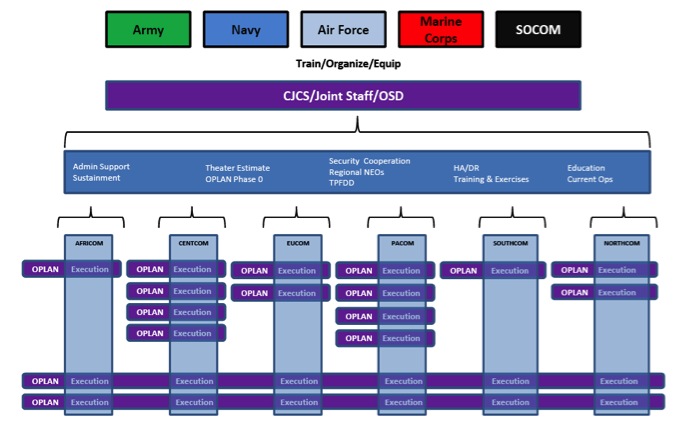
Fig. 1
PEGs are cross-functional teams and are assigned a top priority plan for which they have responsibility for planning and executing across the regional combatant commands. PEGs would operate in much the same manner as Special Operations Command (SOCOM) and Strategic Command (STRATCOM) operate today, but with authorities beyond synchronization, to include prioritization of objectives and geographic regions, personnel, resourcing, and execution responsibilites. PEGs would be coordinated through a PEG Integrator responsible for recommending prioritization of JPEG teams, and the allocation or reallocation of internal PEG resources and personnel as conditions in the environment dictate (see Figure 2 below).
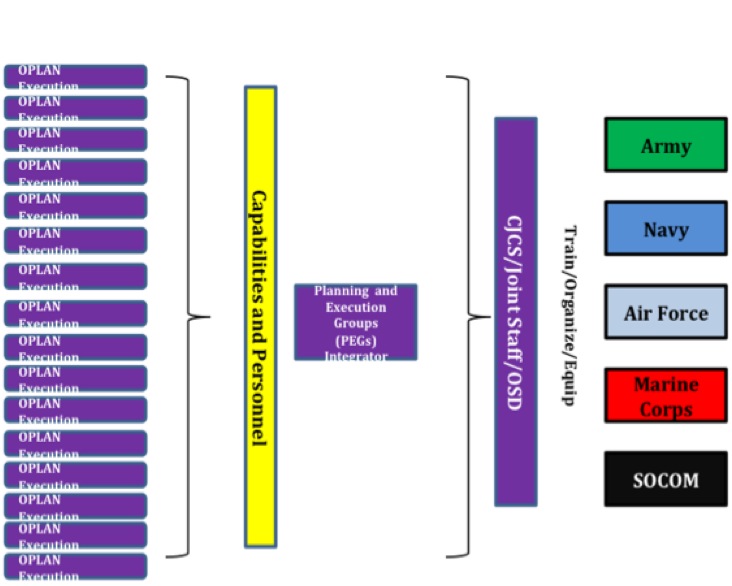
Fig. 2
The PEG Integrator consolidates warfighting requirements thorugh mechanisms similar to current combatant commander warfighting requests through the Joint Staff and Services. Each PEG has responsibilities and authorities similar to those of a subunified command or joint task force, or to that of a unified combatant command for special operations forces as outlined in United States Code (USC) Title 10, Section 167. Each PEG liaises with regional and functional combatant command J-5s (see Figure 3 below) to ensure theater campaign plan integration.
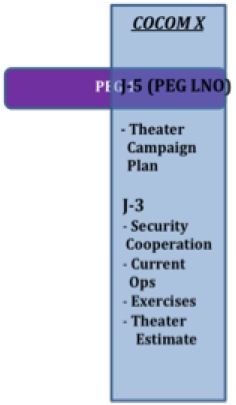
Fig. 3
PEG liaison efforts would require a shared understanding of the theater environment, determine adminstrative and sustainment needs, identify and determine OPLAN Phase 0 activities, determine desired conditions for security cooperation mitigation activities, identify regional and country-specific training and exercise requirements, and determine TPFDD shortfalls.
PEGs work directly for the Under Secretary of Defense (Policy) leveraging the department’s regional and functional defense policy makers. As mentioned above, PEGs integrate plans through combatant commands to ensure regional expertise is integrated and assumptions, environmental conditions, and trends are current and valid. PEGs also maintain an administrative relationship with the Joint Staff through the J-5 to ensure warfighting requirements, risk, and force development requirements are incorporated into the Chairman’s assessments and recommendations as well as through the Joint Chiefs for Service train, organize, and equip needs (See Figure 4).
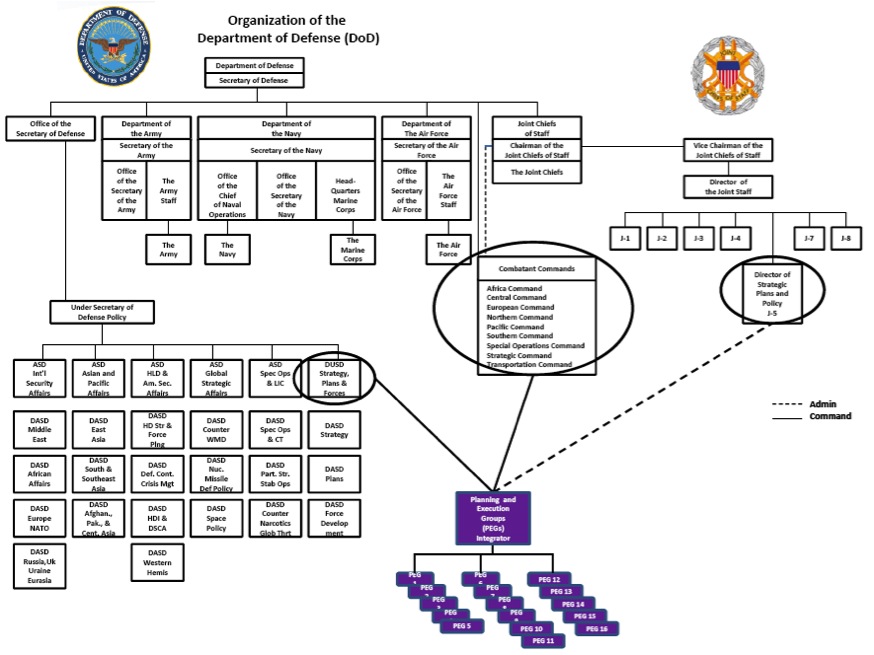
Fig. 4
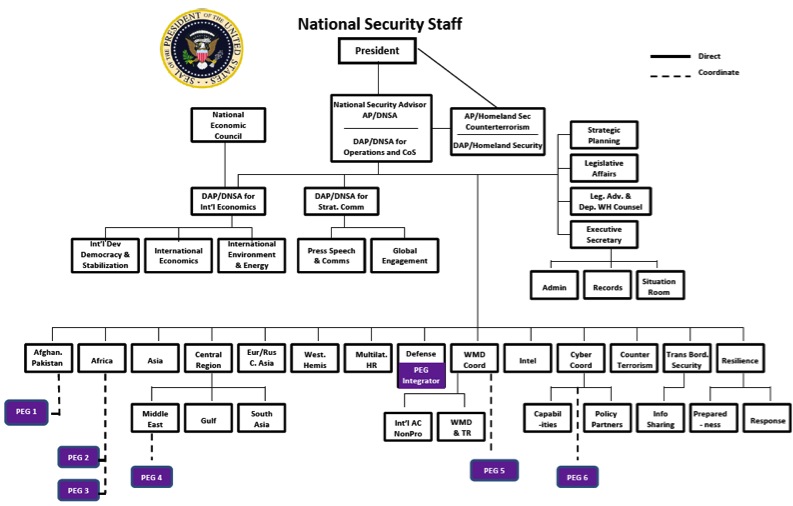
Fig. 5
To address the obvious need for interagency coordination, PEGs have coordination authority with their associated NSC/IPC (see Figure 5) to ensure national security policy and plans are synchronized and integrated during plan development. PEG and IPC coordination throughout the planning process would ensure issues and activities that affect the shaping, deterrence, stabilization, and/or enable civil authorities phases are addressed prior to plan execution (See Figure 6).
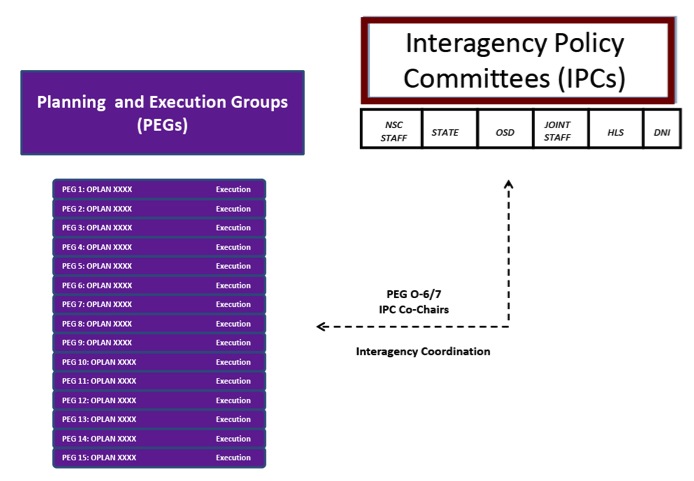
Fig. 6
PEGs are consolidated in the Washington, DC area and individual PEGs would travel to various regional and functional combatant commands as necessary to ensure plan understanding and theater strategy and theater campaign plan integration. The JPEG integrator would ensure cross-plan integration and synchronization occurs, reallocating assets as required in response to environmental conditions. As top priority plans change, PEGs would change accordingly. If a top priority plan were executed, the PEG would form the initial JTF cadre for execution. During OPLAN execution, combatant commanders would not act concurrently as the commander of a subunified command or JTF and would serve primarily in a supporting or sustainment capacity focusing efforts on the day-to-day management of the theater as a whole.
Conclusion
The current strategic environment does not support interagency reform; however, the DoD can make internal reforms that will facilitate interagency coordination and integration while providing needed changes to an outdated defense organizational structure. In a dynamic operating environment, traditional structures become less important (Hoogervorst, Koopman, & Flier, 2002) and emphasis must be placed on adaptive planning and execution groups that reflect environmental realities. Joint Force organizations and senior military and civilian leaders must adapt to these conditions while maintaining the balance between stability and the need for adaptability and innovation (Kast & Rosenzweig, 1979).
A responsive and effective Department of Defense must reconfigure itself to incorporate geographic, functional, process, and product (plan) structures. The proposed DoD reconstruction maintains a large degree of institutional stability while proposing a design that facilitates an interagency approach to those plans deemed vital to the security of the United States. As with any proposal, the “devil is in the details” and this one certainly requires a great deal more discourse. Given the realities of the current fiscal environment, however, the Department of Defense must look inwardly to address operational realities. A reconfigured deliberate planning process that emphasizes speed, adaptability, and decentralization has implications for the entire defense enterprise and will require substantial changes in personnel and promotion systems, acquisition systems, changes in culture and values, and changes in temperament and style of leadership.
References
Cook, J. (2007). The book of positive quotes, 2nd Edition. (Eds.) S. Deger and L. A. Gibson. Minneapolis, MN: Fairview Press.
Dempsey, M. (2012). Mission Command White Paper (3 April 2012). Washington, DC: U.S. Government Printing Office.
Department of Defense (DoD), Chairman Joint Chiefs of Staff (2007). Joint Publication 1, Doctrine for the Armed Forces of the United States, United States Joint Chiefs of Staff/Joint Staff J-7, Washington, DC.
Feickert, A. (2012). The Unified Command Plan and Combatant Commands: Background and issues for Congress. CRS Report for Congress, Washington, DC: Congressional Research Service. Retrieved from: http://www.fas.org/sgp/crs/natsec/R42077.pdf.
Flynn, G. J. (2012). Decade of war, volume 1: Enduring lessons from the past decade of operations. Joint Staff J-7, Joint and Coalition Operational Analysis (JCOA), Suffolk, VA.
Galbraith, J. R. (2000). Designing the global organization. San Francisco, CA: Jossey-Bass.
Galbraith, J. R. (2002). Designing organizations. San Francisco, CA: Jossey-Bass.
Handy, C. (1989). The age of unreason. Boston, MA: Harvard Business School Press.
Hoogervorst, J. A. P., Koopman, P. L. & Flier, H. van der. (2002). Human resource strategy for the new ICT-driven business context. International Journal of Human Resource Management, Vol. 13, Iss. 8.
Jones, J. L. (2009). The 21st Century interagency process. Washington DC. Retrieved from: http://www.fas.org/irp/offdocs/ppd/nsc031909.pdf.
Kast, F., & Rosenzweig, J. ( 1979). Organization and management: A systems and contingency approach. New York: McGraw-Hill Book Company.
Kotter, J. p. (1996). Leading change. Boston, MA: Harvard Business School Press.
Locher, J. R. III (2002). Victory on the Potomac: The Goldwater-Nichols Act unifies the Pentagon. College Station, TX: Texan A & M University Press.
Mylen, J. (2002). Strategic safari, Leadership, January/February.
Nadler, D. A. & Tushman, M. L. (1997). Competing by design: The power of organizational architecture. New York, NY: Oxford University Press.
Obama, B. (2009). Presidential Policy Directive – 1. Washington, DC. Retrieved from: http://www.fas.org/irp/offdocs/ppd/ppd-1.pdf.
Rumsfeld, D. (2011). Known and unknowns: A memoir, New York: Sentinel.
United States Code (USC) Title 10. (2012). Section 167, Chapter 6, Combatant Commands. Retrieved from: http://uscode.house.gov/download/pls/10C6.txt
Windischer, A., Grote, G., Mathier, F., Martine, S. M., & Glardon. (2009). Characteristics and organizational constraints of collaborative planning. Cognition, Technology & Work, Iss. 11.
About the Author(s)
Comments
Dave,
You make some great comments and your point about PDD 56 is right on the mark. PDD 56 was a very well-written document that provided an outstanding framework for interagency coordination--subsequent presidential directives were less effective although I initially had high hopes for Gen Jones' effort, but the political will was/is not there given all of the other issues.
My focus was on the DoD as you point out and some of the internal things that can be done to facilitate interagency policies and planning. OPLANS are but one outcome of interagency coordination--day-to-day global and theater management requires a more comprehensive and far-sighted approach.
Two comments: I still think the 1997 Presidential Decision Directive 56 (The Management of Complex Contingency Operations) still provides one of the best process frameworks for interagency collaboration and coordination for the very reason that DoD is in the lead in very few of the contingencies envisioned in the document. Which brings me to the second point. The essay below is DoD-centric. I think some will be resistant to some of the useful ideas in the essay below because it appears that the effort to fix the interagency process is about improving DoD's efforts to execute (not a bad thing of course) but DoD is already the 600 lb guerrilla/gorilla in the process. We should keep in mind that as important as they are "it is not all about OPLANs." Below are some of my naive thoughts on the interagency:
D.S. Maxwell
27 JAN 2011
SUBJECT: Thoughts on Interagency Operations
The Country Team is the tip of the interagency spear and where the interagency functions best. It would be great if interagency teams inside the beltway could be as effective as a good country team but of course part of the reason country teams are effective is because the members live and work together in a foreign country (which is, of course, outside the beltway!)
To me the key to an interagency team is leadership. Whomever is given lead agency status has to provide a strong leader and build the team rapidly because the team is by nature and definition ad hoc.
This is what I would tell my students if I were king for a day and could direct the operation of interagency teams.
1. An interagency team is about solving complex political, economic, diplomatic or military problems (and usually a combination of some or all). However, before you jump to problem solving you have to start with problem understanding. The key is thorough assessment of the situation looking at the problem(s) from all sides as well a complete understanding and grasp of the policy and strategic guidance from the President. This is most important and most complex; however, often we come up with great solutions but they solve the wrong problems. Assessment must be thorough but also continuous because the planning assumptions must be continually examined and challenged.
2. Members of an interagency team have to check some things at the door: ego, agency equities, and agendas. The only equity is the common one of solving the problem that the President or the Principles have given to the interagency team. Every team member has to ask "is what I am recommending or proposing the best for our nation and for solving the problem in accordance with the President's guidance and intent?" The only "equity" is the common one for all members – the best solution to the problem with acceptable risk to our nation and acceptable cost of blood and treasure that provides the best chance of success.
3. To accomplish number 2 above everyone must abide by the Reagan Principle: (paraphrased here) "It is amazing what can be done when no one worries about whom gets the credit."
4. Although each member of the team brings the expertise of his/her respective agency; the best members of the team have a good working knowledge of, and most importantly respect for, the operations of the other agencies and how they can contribute to solving the problem.
5. Team members must have sufficient authority to speak and make decisions for their agency. If a member has to continually go back to his/her parent agency for guidance and approval that person should be removed and the agency should be forced to send someone who can be trusted with and given sufficient authority.
6. But the above five points all rest on the shoulders of the leader. The interagency team leader must build the team that will have the discipline to follow the above five points. He/She will be successful if all the team members understand the responsibilities of the leader and their own responsibility to support him/her with the above five points.
